One of the most common training questions I get is “How can I stop my dog from growling at other dogs on walks?”
Oh, if only there were an easy fix, right?
I get this question so often that I decided to write a post about it. Now I can direct people here in the future.
As always, go ahead and leave your thoughts/experiences in the comments. And please share this post if it will help a dog you know.
How to stop a dog from growling/barking at other dogs on walks
First, a few “easy” tips to try:
1. Get the right dog training collar or harness.
Seriously. Just do this and make your life easier. You might want to try a couple of options and see what works best for your dog. It’s worth it.
You could try a martingale collar first because it tightens slightly under pressure but is limited in how far it tightens. For that reason it’s called a “limited slip” collar. Unfortunately a martingale collar usually does not give you enough control with a very strong puller, however.
Other training tools that work for a variety of dogs include:
- Gentle Leader (fits over the muzzle)
- EasyWalk no pull harness
- Prong collar
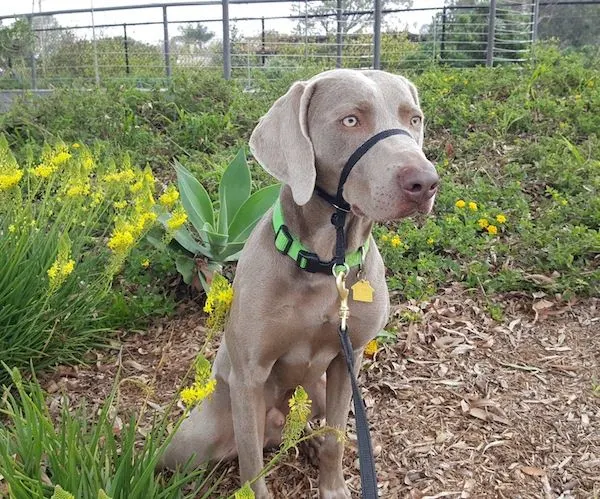
Try not to worry what others think. In reality, most people don’t really care what collar you use. You need to be able to control your dog so your walks are enjoyable and safe.
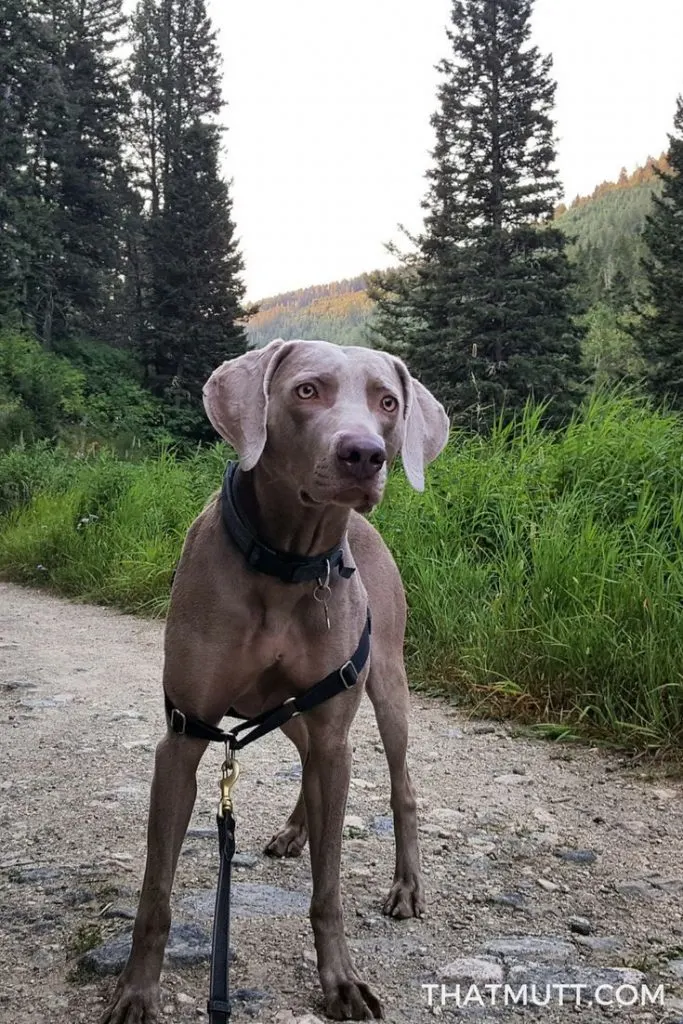
What’s best for one dog will not be the best for all dogs. In my experience as a dog walker and rescue volunteer, the collar that helps me control the most dogs is the Gentle Leader, followed by a prong collar (pinch collar) and then a no-pull harness.
Also, ditch the retractable Flexi leash (for now). Use a 6-foot leash.
2. Keep your dog at your side vs. out in front.
“But she pulls!”
So what. Just keep her at your side anyway using one of the above training collars.
Dogs are less likely to react if they’re at your side vs. out in front of you. And if they do react, it’s much less exaggerated.
How many of you have seen a person walking with their dog several feet ahead, and then sure enough when the dog sees another dog, he goes crazy, lunging and barking as the owner tries to “reel him in”?
Just avoid that embarrassment and keep your dog at your side on walks.
3. Enroll in an obedience class.
This will allow your dog to practice working around other dogs and to learn to pay attention to you even with those distractions.
In addition to the obedience class, I recommend working on lots of training on your own so your dog has rock solid skills as far as sit, down, stay, come, heel.
If your dog has the self-control to follow these words, he will have an easier time remaining calm in “high stress” situations like passing another dog.
You might also like this post: How to get my dog to behave in public.
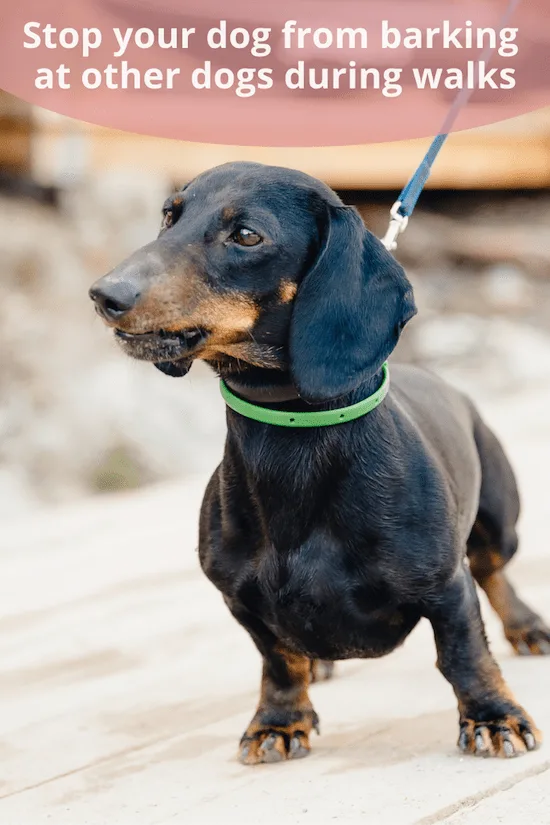
4. Exercise!
I realize exercising a reactive dog is difficult because when you want to walk him you’re going to run into other dogs. All I can say is get creative and make sure you’re providing your dog with adequate exercise.
The less pent-up energy a dog has, the easier it will be for him to remain calm and collected around his “triggers.”
Some ideas for exercise: Long walks in the early morning, walking with a dog backpack, allowing the dog to run in an open area with a long lead, driving to a quiet park to walk your dog.
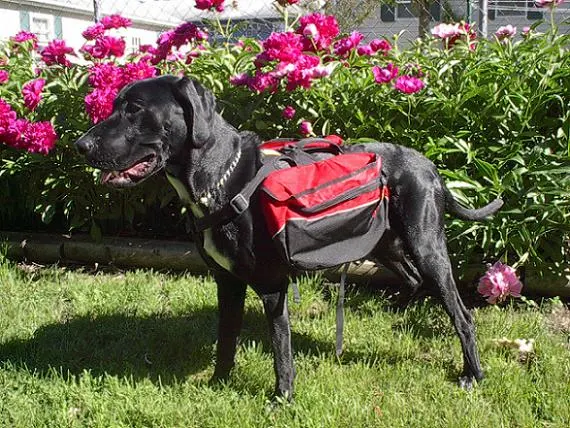
Now, the longer answer …
How to stop a dog from barking at other dogs
The above are important, but they are more about prevention than they are training the dog how to respond appropriately.
So, here’s where I want to recommend a book called “Feisty Fido” by Dr. Patricia McConnell and Dr. Karen London.
“Feisty Fido” is extremely helpful for learning how to set up a step-by-step desensitization/counter-conditioning program for a reactive dog.
Click here to order the book on Amazon.
In summary, it will help you:
- Identify your dog’s exact triggers (Ex.: dog from 25 feet away or closer, men in hats, small dogs that bark, etc.)
- Work within your dog’s threshold to set up positive experiences.
- Slowly change your dog’s emotional response to his “triggers” over time. (Ex.: Dog sees another dog 10 feet away and thinks, “Oh boy! I get hot dogs!”
There will be ups and downs with this type of training program – successes and setbacks. We live in the real world where most of us are limited on time and patience, but I think most people will find the book helpful if they have reactive dogs.
Have you read it?
If so, let me know what you thought of the book.
Click here to order.
Other tips for stopping a dog from barking at other dogs
- Find highly valued treats (hot dogs, pepperonis, real chicken, etc.) CARRY A TREAT POUCH.
- Stay calm and quietly move away, asking your dog to sit.
- Keep your body between you and the other dog whenever possible and do a quick “U-turn” by physically turning into your dog and moving her away as needed. Dog walkers, do you use this trick every day like I do?!
And one more thing, if you live in an apartment, I know that has specific challenges, so here is our article on reactive dogs in apartments.
OK, how about the rest of you?
What thoughts do you have on all this?
What tips or questions do you have about stopping a dog from barking on walks?
*This post contains affiliate links.
Related posts:
- How to get multiple dogs to calm down before a walk
- Stop a dog from whining before a walk
- More tips for managing a leash-reactive dog
Sign up to receive training tips & more in my weekly newsletter:

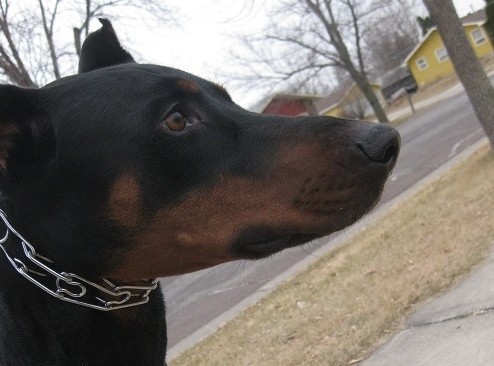

Deborah
Friday 27th of November 2020
One of mine is excellent walks beautifully by my side and rarely reacts to anything. The other one, 3 months younger, reacts to everything! Leaves, grass, dogs, birds, aeroplanes, people though he loves his treats normally at this point NO , he may take it from you but will spit it out. He starts barking almost the second you walk out the door, the only thing that breaks his focus is a jar with dice in. A short sharp shake and a firm NO at the same time and he stops and looks at you and then will sit, look at me, take his treat as soon as you move in any direction bark bark. Funnily enough, he is the gentlest of the two and the cuddliest. They both wear a harness and lead and a slip lead at the same time as I have had a D link snap on a walk, this is fine when he has worn himself out.
Karen
Saturday 25th of May 2019
I got the EasyWalker harness and every time I take Chance out (he is a miniature poodle) is a work session. He has been doing fairly well though he was unhappy about the harness at first. He has even begun to automatically sit when I stop him from pulling ahead. I even got him to not react to 2 different barking dogs. I was encouraged but last night we happened to go out at the same time as some nearby neighbors with their 2 dogs and suddenly Chance went insane. I managed to grab him and turned him away from them but it took at least 5 minutes to get him mostly calmed down. Then I hustled him into the house. I am ordering the Feisty Fido book and we will have to start back at square one.
Ann
Tuesday 30th of April 2019
My dogs (Abby a 9 month old lab and Dash an 8yr old mix breed) were great at not reacting until last week. We were out for a walk on a trail and we were on leash practicing tandeum healing. When a huge golden retriever yes a golden retriever cane charging out of the woods and attacked Dash flattening him and ripping his ear open and biting his neck and dragging him. I dropped the leashes and my pAbby ran away and hid. I couldn’t get the fight broken up and the golden retrievers owner was no where to be found. Seemed like forever before he arrived and the two dogs were separated. Now my puppy is afraid of any dog that barks and my old boy refuses to walk if their is a dog coming to wed him or behind him. He sits and wants to wait. Which is ok for now but if the other dog owner can’t control their dog and the dog comes near my Dash barks. So sad for them both because we love our walks together.
Lindsay Stordahl
Tuesday 30th of April 2019
I'm so sorry to hear this happened to you. Hopefully you can seek out some positive experiences with other dogs that are calm and friendly and gentle.
GREGG GOEHLER
Monday 3rd of December 2018
I adopted an American Bull Dog/mix, 78lbs., 3 years old and very hard headed. I can tell he never had toys to play with, if I throw a ball he just looks at it bounce by him and tug ropes he would barely mouth. One of my neighbors adopted the same day I did and the two dogs are the best of friends. They will run and play and wrestle each other for hours. When we approach other dogs mine will whine, cry, bark and try to get to them. I don't think he wants to hurt them but, I think the other dog is fearful because of my dog's size. After I move closer to the other dog I turn my dog's rear to the new dog so he/she can smell it. This tends to calm my dog and the other dog down. Mine will then greet the other dog face to face. They tend to get along after that. One trick I use that helps getting his attention while on walks is I keep the squeaker from destroyed pet toys and I use it when he is focussed on other dogs, people or whatever and not listening to my commands It breaks his concentration for a minute and I get him to focus on me. I really like this POST. Thanks
Sharon Wollenberg
Monday 29th of January 2018
I personally like the prong collars for larger dogs that are hard to manage on a walk. They work well on smaller dogs too. I also avoid other dogs on walks as a rule. You just never know. I cross the street or just turn around. I will say "leave it" I always keep them at my side and in control. I always want to know what triggers them and try to correct it or avoid all together. Sometimes it is impossible to do. Sometimes I use a really good treat (really smelly) to distract them. I won't give it to them unless they did really good and a reward for good behavior. Easier said then done.